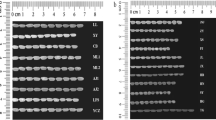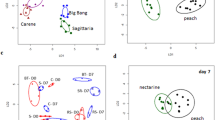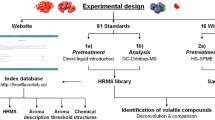Abstract
Traditional flavor analysis relies on gas chromatography coupled to mass spectrometry (GC-MS) methods. Here we describe an indirect method coupling volatile compound formation to an ARO9-promoter-LacZ reporter gene. The resulting β-galactosidase activity correlated well with headspace solid phase micro extraction (HS/SPME) GC-MS data, particularly with respect to the formation of rose flavor. This tool enables large-scale screening of yeast strains and their progeny to identify the most flavor active strains.
Similar content being viewed by others
The organoleptic perception of beer depends mainly on substances produced by yeast during the fermentation process. Flavor active substances are volatile compounds and include higher alcohols, esters and fatty acids. In the wine industry attempts are made to increase flavour compounds by either simultaneous or sequential co-fermentations using either different yeast strains, i.e Saccharomyces cerevisiae with a non-Saccharomyces yeast, or mixing bacterial strains, e.g. Oenococcus oeni, with wine yeasts5,8,14,17. Research interest in natural flavors produced by yeasts has gained increasing interest, particularly focusing on isoamyl alcohol (banana flavor) and β-phenylethanol (flowery, rose flavor). Both compounds are produced during amino acid catabolism in yeast9. The Ehrlich pathway, a linear pathway requiring three enzymatic activities, is responsible for converting aromatic amino acids (phenylalanine, tyrosine and tryptophan), branched-chain amino acids (leucine, isoleucine and valine) and methionine into higher alcohols. The regulation of the Ehrlich pathway depends at least in part on the Zn2Cys6 transcription factor Aro80, which regulates ARO9 and ARO10 in a nitrogen source dependent manner (Fig. 1A)12. One of the key bottle necks in flavor research is the requirement of chemical analytical tools to measure volatile compounds produced during fermentation, which is generally done using HS/SPME extraction methods coupled to GC-MS2,15. This method, however, is time consuming, requires additional quantitation as well as prior lab scale fermentations and sample preparations, which are often difficult to optimize for high throughput screening.
Identification of a reporter gene for Ehrlich Pathway activity.
(A) Amino acids (branched-chain amino acids, leucine, isoleucine and valine, aromatic amino acids, phenylalanine, tyrosine and tryptphan, or methionine) are converted in the Ehrlich pathway to fusel alcohol or fusel acids in a three step process. The genes encoding enzymes that catalyze single steps are indicated. Oxidation of aldehydes to fusel acids is done by aldehyde dehydrogenases (e.g. ALD1). Reduction of aldehydes to fusel alcohols is done by alcohol dehydrogenases (e.g. ADH1). Transcriptional regulation by Aro80 and co-factor requirement is indicated. (B) Plasmids carrying the ARO80 overexpression and one of the ARO-promoter-lacZ reporter gene constructs were co-transformed into S. cerevisiae (BY4741). (C) Quantitative β-galactosidase assay with strains bearing the indicated ARO-promoter-lacZ constructs in strains in which ScARO80 was either overexpressed or deleted, or contained the wildtype ARO80.
In order to identify a promoter that is most responsive to ARO80 overexpression, we co-transformed ARO80 under the control of the Ashbya gossypii TEF-promoter with plasmids containing ARO8, ARO9, ARO10 and ARO80 promoter-lacZ reporter gene fusions into S. cerevisiae (Fig. 1B). To investigate whether expression of the reporter genes was actually Aro80-dependent we quantified β-galactosidase activity in strains bearing the endogenous ARO80, an ARO80 deletion, or the ARO80 overexpression construct (Fig. 1C). This established the ARO9 as a potential reporter for a strain's flavor production.
To correlate ARO9 reporter gene activity with flavor formation we first determined its activity in a set of strains with S. cerevisiae background expressing ARO80 at wild type levels. This included the laboratory strain CENPK, two hybrid lager yeast strains, collectively known as S. pastorianus as well as a Bordeaux wine yeast. For comparison we used these strains in bench-top fermentation assays and at the end of fermentation volatiles were extracted by HS/SPME and analyzed via GC-MS (Tab. S1). For the comparison of volatile compound formation with β-galactosidase activity we focused our attention to phenylalanine catabolites (rose flavor). This showed that β-galactosidase activity of the ARO9-lacZ reporter correlated well with the amount of β-phenylacetate and β-phenylethanol produced by these strains (Fig. 2).
Comparison of β-galactosidase activity with volatile compound formation.
(A) Assay with either the indicated S. cerevisiae strains (A) or with Saccharomyces sensu stricto strains (B). Upper panels depict β-galactosidase activity based on the ARO9p-lacZ reporter construct. Lower panels show β-phenylethanol and β-phenylacetate volatile compounds. Note: Fermentation with the wine strain in (A), was done in YPD due to its lack of MAL-genes. The low amount of flavor produced by S. mikatae, S. cariocanus and S. cerevisiae in (B) is due to their inability to end-ferment granulated malt used in these fermentations. Correlation of  -galactosidase activity and the combined yield of phenylalanine catabolites are shown in (C).
-galactosidase activity and the combined yield of phenylalanine catabolites are shown in (C).
To determine the applicability of this tool beyond S. cerevisiae we used the ARO9-reporter with strains from the Saccharomyces sensu stricto complex including S. bayanus, S. cariocanus, S. eubayanus, S. kudriavzevii, S. mikatae, S. paradoxus and S. uvarum (Fig. 2). The flavor profiles show that there is a great variability in volatile formation between these strains (Tab. S1). This variability is also reflected in the β-galactosidase activity in these strains indicating that high β-galactosidase activity pairs with increased flavor production. A correlation curve was analyzed comparing β-galactosidase activity with the combined flavor values for 2-phenyl ethanol and 2-phenyl acetate (Fig. 2C). This took into account that Aro9 enzymatic activity is upstream of 2-phenyl ethanol and 2-phenyl acetate production.
Fermented beverages contain only small amounts of volatile compounds; yet, these are of paramount importance for the flavor profile and organoleptic perception of a beverage19,20. Changes in brewing technology, e.g. introduction of high-gravity brewing, can drastically alter the flavor composition - in this case - by resulting in an increase in the amount of acetate esters. Consumer preference is towards all natural flavors and unique flavor signatures10. Based on this non-GMO preference, three main roads are currently followed to improve flavor content of beverages: (i) choice of the starter culture, (ii) mixed fermentations using different yeast species or a combination of yeast and bacterial species and (iii) selection of strains high in volatile compound formation via yeast breeding approaches1,5,6,22.
For example, yeasts belonging to the genera Hanseniaspora and Pichia are good producers of acetate esters, whereas mixed fermentations with S. cerevisiae and Lachanceathermotolerans increased the level of β-phenylethanol4,21. Furthermore, mixed fermentations, including S. cerevisiae and a bacterial strain e.g. Oenococcus oeni, promise to provide novel flavor variations17.
With the highly advanced gene function analyses in S. cerevisiae the genetic repertoire involved in volatile compound formation has been elucidated to a great extent18. The Ehrlich pathway plays a central role in aromatic and branched-chain amino acid catabolism resulting in the conversion of amino acids to aroma compounds9. Several studies have described an increase in flavor production by selecting for yeast strains resistant to fluoro-amino acids. An increased production of isoamyl alcohol, for example, can be achieved by selecting mutants resistant to trifluoroleucine3. In such strains a mutation of D578Y in the LEU4 gene releases feedback inhibition and initiates increased production of leucine and its catabolites16. Using a genetic approach it was shown that overexpression of the alcohol acetyl transferases ATF1 and ATF2 substantially increased the production of isoamyl acetate20.
The indirect assay described in this study converts Ehrlich pathway activity into a reporter gene readout that can be quantified as β-galactosidase activity. We base the tool on the ARO9 promoter as the ARO8 promoter was not responsive to Aro80 and has been shown to be under general control13. With this method we can preferably assay rose flavor. Apparently, however, this reporter is not discriminatory towards branched chain amino acids (Tab. S1).
Our tool is fast and convenient and can be adapted for use with high throughput microtiter plate assays in yeast7,11. Thus this indirect flavor assay system is inexpensive and allows screening of large libraries of yeast strains as well as F1/F2 populations of interbred strains. This will lead to the rapid identification of strains with potentially improved flavor characteristics compared to the parental strains. Additionally, different growth regimes can lead to altered flavor production. This allows the implementation of changes in oxygen supply and use of different nitrogen sources.
References
Arroyo-Lopez, F. N. et al. Yeasts in table olive processing: desirable or spoilage microorganisms? Int J Food Microbiol 160, 42–49 (2012).
Canuti, V. et al. Headspace solid-phase microextraction-gas chromatography-mass spectrometry for profiling free volatile compounds in Cabernet Sauvignon grapes and wines. J Chromatogr A 1216, 3012–3022 (2009).
Casalone, E. et al. Genetic and biochemical characterization of Saccharomyces cerevisiae mutants resistant to trifluoroleucine. Res Microbiol 148, 613–623 (1997).
Comitini, F. et al. Selected non-Saccharomyces wine yeasts in controlled multistarter fermentations with Saccharomyces cerevisiae. Food Microbiol 28, 873–882 (2011).
Domizio, P. et al. Outlining a future for non-Saccharomyces yeasts: selection of putative spoilage wine strains to be used in association with Saccharomyces cerevisiae for grape juice fermentation. Int J Food Microbiol 147, 170–180 (2011).
Garcia Sanchez, R., Solodovnikova, N. & Wendland, J. Breeding of lager yeast with Saccharomyces cerevisiae improves stress resistance and fermentation performance. Yeast 29, 343–355 (2012).
Gietz, R. D. & Schiestl, R. H. Microtiter plate transformation using the LiAc/SS carrier DNA/PEG method. Nat Protoc 2, 5–8 (2007).
Gobbi, M. et al. Lachancea thermotolerans and Saccharomyces cerevisiae in simultaneous and sequential co-fermentation: a strategy to enhance acidity and improve the overall quality of wine. Food Microbiol 33, 271–281 (2013).
Hazelwood, L. A., Daran, J. M., van Maris, A. J., Pronk, J. T. & Dickinson, J. R. The Ehrlich pathway for fusel alcohol production: a century of research on Saccharomyces cerevisiae metabolism. Appl Environ Microbiol 74, 2259–2266 (2008).
Hugenholtz, J. Traditional biotechnology for new foods and beverages. Curr Opin Biotechnol 24, 155–159 (2013).
Ichikawa, K. & Eki, T. A novel yeast-based reporter assay system for the sensitive detection of genotoxic agents mediated by a DNA damage-inducible LexA-GAL4 protein. J Biochem 139, 105–112 (2006).
Iraqui, I., Vissers, S., Andre, B. & Urrestarazu, A. Transcriptional induction by aromatic amino acids in Saccharomyces cerevisiae. Mol Cell Biol 19, 3360–3371 (1999).
Iraqui, I., Vissers, S., Cartiaux, M. & Urrestarazu, A. Characterisation of Saccharomyces cerevisiae ARO8 and ARO9 genes encoding aromatic aminotransferases I and II reveals a new aminotransferase subfamily. Mol Gen Genet 257, 238–248 (1998).
Kim, D. H., Hong, Y. A. & Park, H. D. Co-fermentation of grape must by Issatchenkia orientalis and Saccharomyces cerevisiae reduces the malic acid content in wine. Biotechnol Lett 30, 1633–1638 (2008).
Mauriello, G., Capece, A., D'Auria, M., Garde-Cerdan, T. & Romano, P. SPME-GC method as a tool to differentiate VOC profiles in Saccharomyces cerevisiae wine yeasts. Food Microbiol 26, 246–252 (2009).
Oba, T., Nomiyama, S., Hirakawa, H., Tashiro, K. & Kuhara, S. Asp578 in LEU4p is one of the key residues for leucine feedback inhibition release in sake yeast. Biosci Biotechnol Biochem 69, 1270–1273 (2005).
Rossouw, D., Du Toit, M. & Bauer, F. F. The impact of co-inoculation with Oenococcus oeni on the trancriptome of Saccharomyces cerevisiae and on the flavour-active metabolite profiles during fermentation in synthetic must. Food Microbiol 29, 121–131 (2012).
Styger, G., Jacobson, D., Prior, B. A. & Bauer, F. F. Genetic analysis of the metabolic pathways responsible for aroma metabolite production by Saccharomyces cerevisiae. Appl Microbiol Biotechnol 97, 4429–4442 (2013).
Verstrepen, K. J. et al. Flavor-active esters: adding fruitiness to beer. J Biosci Bioeng 96 (2003).
Verstrepen, K. J. et al. Expression levels of the yeast alcohol acetyltransferase genes ATF1, Lg-ATF1 and ATF2 control the formation of a broad range of volatile esters. Appl Environ Microbiol 69, 5228–5237 (2003).
Viana, F., Gil, J. V., Genoves, S., Valles, S. & Manzanares, P. Rational selection of non-Saccharomyces wine yeasts for mixed starters based on ester formation and enological traits. Food Microbiol 25, 778–785 (2008).
Zott, K. et al. The grape must non-Saccharomyces microbial community: impact on volatile thiol release. Int J Food Microbiol 151, 210–215 (2011).
Acknowledgements
This research was supported in part by the European Union Marie Curie Initial Training Network Cornucopia (http://www.yeast-cornucopia.se/).
Author information
Authors and Affiliations
Contributions
D.R. carried out the molecular experiments; D.R. and K.T. carried out flavor measurements; A.W., J.W.W. and U.V. designed the experiments, A.W. and D.R. prepared the figures, J.W.W. wrote the main manuscript text; all authors reviewed the manuscript.
Ethics declarations
Competing interests
The authors declare no competing financial interests.
Electronic supplementary material
Supplementary Information
Suppl Material 1
Rights and permissions
This work is licensed under a Creative Commons Attribution-NonCommercial-NoDerivs 3.0 Unported License. To view a copy of this license, visit http://creativecommons.org/licenses/by-nc-nd/3.0/
About this article
Cite this article
Ravasio, D., Walther, A., Trost, K. et al. An indirect assay for volatile compound production in yeast strains. Sci Rep 4, 3707 (2014). https://doi.org/10.1038/srep03707
Received:
Accepted:
Published:
DOI: https://doi.org/10.1038/srep03707
This article is cited by
-
Use of the Saccharomycopsis schoenii MET17 promoter for regulated heterologous gene expression
Current Genetics (2024)
-
The amazing potential of fungi: 50 ways we can exploit fungi industrially
Fungal Diversity (2019)
-
Use of non-conventional yeast improves the wine aroma profile of Ribolla Gialla
Journal of Industrial Microbiology and Biotechnology (2015)





